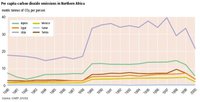Northern Africa and the atmosphere
- Natural, such as dust and sandstorms; and
- Anthropogenic activities including stationary sources, such as thermal power generating plants and industrial parks, and mobile sources including vehicles.
Libya has the highest per capita share of CO2 emissions compared to its neighbours. All countries have experienced significant growth in CO2 emissions, which is often related to economic growth.
Cairo, the capital of Egypt, has poor air quality. The average inhabitant ingests more than 20 times the level of accepted air pollution. When this is manifested as smog – known to Egyptians as the Black Cloud – health problems ensue.
In Tunisia, energy generation and the transport sector are among the major contributors to air pollution, at 31 per cent and 30 percent respectively. The transport sector is the top contributor of CO2 and lead emissions. CO2 emissions account for 92 percent of the total green house gas (GHG) emissions, while methane emissions account for 7 percent, and nitrogen oxide for 1 percent. GHG emissions of CO2 from the transport sector rose from 3.4 million tonnes to 5.8 million tonnes between 1994 and 2002, with an annual increase rate of 9 per cent. They also accounted for about 29 percent of the total emissions generated by the energy sector in the year 2002, rising from 23 percent in 1994.
The national plan to survey air quality in Tunisia is based on the installation of a network of fixed stations and the acquisition of mobile laboratories to monitor air quality and control the sources of pollution. By 2002, five stations had been set up. The stations revealed that, except at peak hours during which time higher elevations in the concentrations of CO2 and SO2 were recorded, the air quality in Tunisia conforms to standard. A national commission for the protection of the ozone layer was established in which all relevant ministries are represented.
In Libya, the main sources of air pollution are related to the use of petroleum derivatives as fuel in many industrial, artisan and transport fields. Oil refineries are the main sources of atmospheric pollution due to the harmful gas emissions, mainly hydrocarbons, carbons, nitrogen oxides and sulphur from burning fuel in oilfields and refineries. Most of the plants were not subjected to environmental evaluation prior to their establishment, and they have adverse effects on the surrounding residential and maritime areas. The plants do not have the necessary pollution control, monitoring and measurement systems, nor the necessary equipment and devices for limiting or decreasing the volume and concentration of the pollutants.
In Morocco, the emissions of GHG and the use of ozone depleting substances (ODS) contributes little to the pressures on the environment. Air pollution is mainly due to road traffic and industry, particularly along the Mohammedia-Safi road axis. The effect of the deterioration of air quality on the economy, in terms of the decrease of productivity due, in part, to respiratory diseases, is estimated at 1.9 percent of the Gross Domestic Product (GDP).
All countries experienced significant growth in emissions], which is often correlated with economic growth. For example, there was a 14.28 percent increase in per capita CO2 emissions between 1990 and 2001 in Libya.
There has recently been increasing awareness of the diverse and complex results of air pollution. Public and private sector establishments are becoming more interested in undertaking preventive measures to control air pollution, and there is a detectable shift from end-of-pipe treatments to a more proactive approach. including cleaner production and waste minimization at source. National Cleaner Production Centres have been established in some countries, such as Morocco and Tunisia, and will soon be set up in Egypt, to raise awareness, build the capacities of development partners, and support stakeholders.
There are many instances of how industries are integrating environmental considerations into industrial development and implementation. For example, some SMEs (small and medium enterprises) have been keen to incorporate the components of environmental management systems (EMS) into their day-to-day operations. For example, the Coptic Evangelical Organization for Social Services (CEOSS), an Egyptian non-governmental organization (NGO), has mobilized approximately US$1 million to institutionalize EMS in SMEs of western Minya in Upper Egypt. In both Egypt and Morocco there has been some investment in the development of renewable energy.
The Egyptian government has been working with USAID to plan a combined natural gas/solar power plant in Egypt. Feasibility studies have been completed on the 127-MW plant, which will use solar energy during the day and natural gas at night. The plant, which has received funding from USAID and the Global Environmental Facility (GEF), is expected to cost $120 million and come online in 2006.
Further Reading
- EIA, 2005. Egypt: Environmental Issues, EIA Country Analysis Briefs. Energy Information Administration.
- Evans, J., 2004. Every Breath You Take: Every time you inhale these days, you are subjecting yourself to possible health risks. Al-Ahram Weekly, 11-17 November, Issue No. 716.
- Firadi, R., 2004. Report on the future of the environment in Africa, Morocco’s contribution to AEO-2 (Unpublished Report).
- Soussi, N., 2004. The Future of Environment in Africa: the Past, the Present and the Future Perspectives,Tunisia’s contribution to AEO-2. (Unpublished Report).
- Tunisia, 2002. National Report: The State of the Environment. Ministry of Agriculture, the Environment and Water Resources, Tunis.
- UNEP, 2006. Africa Environment Outlook 2
- WRI, 2005. EarthTrends: The Environmental Information Portal. World Resources Institute,Washington, D.C.
|
|
| Disclaimer: This article is taken wholly from, or contains information that was originally published by, the United Nations Environment Programme. Topic editors and authors for the Encyclopedia of Earth may have edited its content or added new information. The use of information from the United Nations Environment Programme should not be construed as support for or endorsement by that organization for any new information added by EoE personnel, or for any editing of the original content. |

